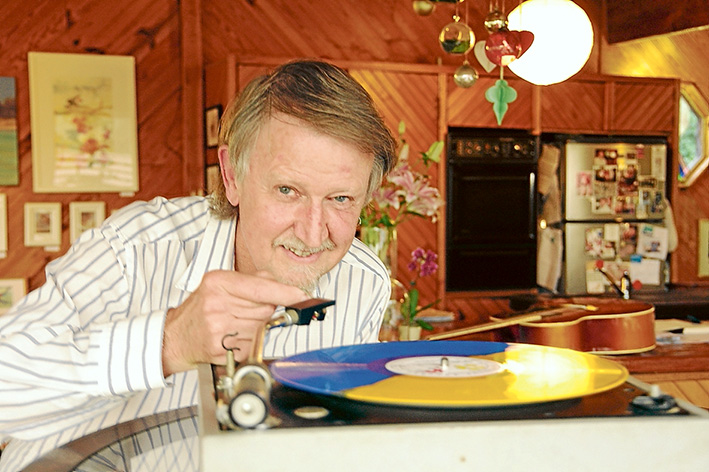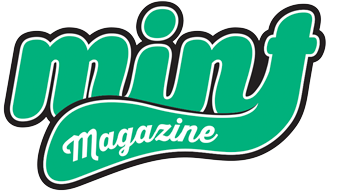By KEITH PLATT

Steve Warner is a journeyman musician. Versatility and a readiness to try anything connected with playing and performing has enabled him to make a living in what is a very fickle industry.
He’s felt the adulation of fronting a band wearing colourful clothes onstage and he feels satisfaction when he hears interpretations of the knowledge he’s passed on to his students.
In between those two ends of the musical spectrum, Warner has scored for TV shows, recorded for advertisements, weddings, and performed at parties and everything and anything else in between.
Quietly spoken and reflective, Warner has undoubtedly had an influence on the Melbourne music scene.
The music that influenced him is passed on to his young students who then use that knowledge as raw material from which to create their own sounds.
Musical passages are handed down like stories and fables.
“Your theory [about passing on influences] is a true one, and what a wonderful thing it is. That an essential part of our culture, our heritage, and in a way ourselves, is being transmitted through the generations via music and song,” Warner says in one of many emails we trade while preparing this article.
“I was influenced in my early years by my brother Tim and his guitar playing mates, six or eight of them, who were into the folk revival in the 1960s. They’d all go down to Fisherman’s Beach [Mornington] on summer’s nights with a guitar and a bottle or two, light a fire and start playing,” Warner says.
“They’d play Bert Jansch, Pete Seeger, Bob Dylan, Donovan, Davy Graham, Big Bill Broonzy and Leadbelly. They’d be doing all those leading bass lines that connect the chords and lots of finger picking, Travis picking we call it now.
“This is at the roots of so much alternative folk and quite a lot of mainstream stuff that I work on a daily basis with the guitar students. I love it. Everything old is new again.
“Sometimes I see an old student playing somewhere, maybe in a fresh new band, and I see my guitar style hidden away in there among all the new sounds.
“Music is so amazingly adaptable. You can show someone a song or a pattern, or a technique, and you hear it later transformed and adapted to a new setting.
“Casey Benetto – who wrote the musical Keating! – I taught for a long time up at Montsalvat, then at our place at Warrandyte. Talk about The Human Dynamo as a kid.
“And of course it’s a special thing when I hear Lawrence Greenwood [playing in Whitley], whose music I love. To think I used to teach him baritone uke at primary school.
“The interesting thing is that you could sense, even as kids, that something significant would happen with each of them, no two ways about it.”
Warner compares this thread to “passing on a burning flame, which can ignite lives and ideas down the years.”
He says music can be powerful and subtle.
“I used to gig weekly at a bar in a rough neighbourhood. They booked me to play in the lounge, but really wanted me to play in the bar. I wondered what the problem was and why they were not being straightforward with me.
“On the third week they took me in to see the bar and I was not happy as it was very rough, very seedy and had a very sticky carpet. I agreed to play with a big bouncer each side of me, no kidding. Anyway, it all went well and I made peace with the locals and we would have these amazing nights.
“Six months later they told me they’d hired me to try to get the violence level down in the bar. I looked blankly at the boss and he said: And it worked.
“It worked because music can subtly charge your mood and your outlook without you ever realising it.”
November saw a piece of Warner’s musical history repeated: the re-release of his solo, self-titled album, Steve Warner.
It was first released in 1979 and now, repressed in yellow and blue vinyl, is also available digitally.
Warner was already negotiating with the Australian label Buttercup when alerted to the value of original copies being traded on eBay, with at least one selling for $500.
He’d already decided the time was right for a re-issue of his music which in today’s terminology would be seen as “psych (edelic) folk or maybe art-folk”. Back then it was described as “acid-folk.”
“The way this album re-release came about was such a total surprise to me and I hadn’t really thought about it in a couple of decades. I’d had only a couple of tiny clues that there was a rekindled interest out there,” Warner says.
“An old mate of mine, the stunning uke player A G Leonard, called and asked if he could have a chord chart for the opening track, Summer. He had become a little obsessed with it. This would have been in 2012 and the song from 1975. I didn’t quite get it, but was happy.
“Maybe 12 months after that I was asked by someone up on the north New South Wales coast wondering if I had any spare copies. This guy had obviously listened to it a lot and made some astute observations about musical influences.
“Again, I thought ‘what the’.
“Maybe a year later an email came in from Scotti, who runs the small independent Aussie label, Buttercup Records, wanting to release it on vinyl, a really arty package with a mini poster, extra inner sleeve photos, download card, my music timeline – and a CD. This time I took notice and paid attention. This was fantastic.
“It turned out that the guy who would do the mastering was an old guitar student of mine, Mikey Young, who went on to do a great job.”
Fire Records, London, then asked Warner if he was interested in a worldwide release on its Earth label.
“They would co-operate with artwork, even on some of the production. Well… err… yes.
“All these folk have been great to deal with and the whole project has been interesting. I get the feeling with Fire that the music itself is on an equal footing with the act of making a buck. These two things must coexist to make the whole thing work, and unlike some enterprises they seem to have a healthy respect for the actual music.”
Much as he enjoys teaching, Warner believes it has held back his performing and composing career.
“Because I enjoy teaching so much, I find it a very creative thing to do and it fulfils and satisfies [that] part of me that would normally be spent performing or recording more.”
Warner grew up in Mornington and when aged 10 was inspired when his father introduced him to a jazz drummer. A few years later he was led towards the electric guitar curtesy of his brother Tim (who later ran the Mornington Music centre).
“I began playing music with the Mornington Youth and Citizens Band, down in the park near the pier, every Wednesday night in the dusty old hall. Afterwards there would be cups of hot tea from the urn and sweet biscuits alongside the euphoniums and cornets. I was a kid drummer and on occasion we could be seen marching down Main St on Anzac Day or with the annual billy cart derby.
“Practicing in the old hall I discovered a whole other world listening to The Banana Boat Song and The River Is Wide and the way the music operated on multiple levels – a bass line, a melody line and at least one more line in the middle. I loved the middle line, usually from a row of horns who sat just in front of the drums.”
He says the citizens’ band helped him to “listen to music with more awareness, not just the obvious front vocal or lead guitar doing its thing, but also to how this music was made to work, how it achieved creating this mighty illusion of another musical place in your mind.”
“Yep, even when I was a Cream and Hendrix-obsessed teenager blasting it out on my Strat and a 100 watt amp at a local dance.”
Warner’s first gigs were as a member of Satan’s Slaves, a four-piece that he now sees as having a name that seems incongruous when playing their regular gig – Mornington church dances.
Eight years and many moves and sounds later he was freshly back from living in Tasmania playing with Spiff Rouch and the Untouchables. He left when “the fellas started making serious noises about taking it to the next level.” The remaining Spiffs kept exploring their “satire rock with a retro surf twist” before moving on to form “the core” of Australian Crawl.
The formalities out of the way, Warner was about to enter the decade that in all probability remains the biggest influence on his life today.
Warner’s recollections of making music in 1975-85 seems like he was caught in a creative whirlwind.
There’s a seemingly never ending list of bands and appearances and bits of producing for other musicians. During a six-week stint at a club in Cairns came the realisation that “I could feed my young family by playing covers.”
It hasn’t been done yet, but Warner says “a book could be written about that decade.”
It was also the time of the initial release of that first album, Steve Warner.
Recorded in 1976 at a “big white three-storey house” overlooking Hobart, Warner tells of borrowing a trail bike to make it up the steep road each day.
There was no rush to record and he experimented with slowing tapes and, for one track, fitting his guitar with “weird rope-core strings.”
Looking back, he sees he was obsessed with playing every instrument, singing every part: “Others can do most of this better than I can – it’s just something I have a need to do. Later, listening back in the control room – hmm. This can be a heightened experience on a project that has had a lot of planning – and when it’s working, this moment is where it’s at, for me.”
The sounds he chose for the album come from a variety of sources – guitar, piano, flute, bass, glockenspiel, percussion instruments (“some homemade or found”), a mono synth and clarinet.
Before entering the studio Warner and a close knit group of musicians had performed regularly around Melbourne’s coffee houses and folk clubs “cutting our performing teeth.”
“But this project sprang from a different beginning, one rooted in endless days and nights of recording at home as a teenager, making music in layers upon layers, discovering the concept of arranging, and of finding ways to make my reel-to-reel do things that it was never intended to do.
“The actual recording experience was wonderful, down in quiet little Hobart. I’d lived in Tassie before, shacked up in an old farmhouse on 20 acres overlooking the water. It was pretty rugged living sometimes, but interesting with lots of quirky locals. We had a little trio with two guitars and all three of us sang in harmony.
“I did a little freelance recording at a studio – Spectangle Productions – a couple of ads and a little composition for folk.
“The ’70s was an interesting decade in which to write and record music. Coming on the heels of the ’60s when a lot of what I would call art music wasn’t hidden away in some tiny sparsely-attended venue, but right there in our faces. Sgt Peppers or Pet Sounds or Donovan’s Sunshine Superman – what an amazing influence that album had on me in retrospect. The ’70s dawned only a few years later, but so much had changed too.
“It was a positive time to be making music with a certain freedom that the previous decade had left us, at least those of us on the alternative scene.
“It seemed that pop music was becoming more and more restricted into formulas, while the alternative scene was flourishing. I reckon my peer group managed to live for an entire decade without once tuning in to commercial radio. Boy, were we off the radar.
“I was enjoying writing songs that used weird-but-beautiful chord combinations and changed key freely but, hopefully, still hung together by long threads of harmony. Listening back all these years later, I must have been listening to Debussy and Ravel – that Paris turn of the century sound that I still adore.
“I was certainly listening to Stravinsky alongside my three old Hendrix albums and Crosby Stills Nash & Young, Jackson Browne, James Taylor and Joni Mitchell. Now there’s a woman who carved out her own place in music history. I still listen to her albums from Blue to the jazz-influenced Hejira.
“James Taylor recently said that one of the strongest influences on his musicality was Anglican church hymns. When you listen to his guitar lines with that in mind, you really can hear it loud and clear. Music is such an interesting thing.”
Sometime after it was recorded, having Steve Warner pressed was a solo project that Warner’s then girlfriend and now wife, Tammy, and a couple of friends “joined forces and made me promise to finally do.”
Neil Young’s line “24 and there’s so much more” was also echoing around his head, “needling me to get this thing underway. I got there just in time.”
He was also “leaving behind a couple of years of dark, brooding, debilitating depression. Like a long, hidden, gloomy, subterranean tunnel with no exit, it had confused, engulfed and battered me until I could hardly breathe.”
Warner credits Tammy’s “love and perseverance” in helping clear his mind and getting him back where he felt at home – in the recording studio.
“This was a world I understood, the colours and textures of chords and harmony, and the journey that they can take you on if you are willing to follow.”
Back on the mainland and living in a mud brick house at Eltham near the Yarra River with 500 completed vinyl records, he and Tammy set about hand silk screening the album covers.
They were in a rented house “we couldn’t afford,” with covers spread over the floors and “pots of thick ink everywhere, turps, rags, squeegees, big screens, cardboard cover blanks and the smell of printing.”
The process was character building.
Warner and Tammy now live in a house on a steep unmade road in Mt Martha. The main timber lined room looks out towards a bush-filled creek gully. It is open plan living. The kitchen is part of the room which also doubles as artist Tammy’s studio and is included on the annual Mornington Peninsula Artists’ Trail.
Warner also released the CD “Sketches of Paradise” in 1991 and has started recording a new instrumental album “with a fantastic quartet.”
The album is also retro packaged, coming in a protective clear plastic sleeve (they used to cost extra) the fold-out cover has liner notes, a rundown of Warner’s “musical moments and movements” and a couple of extra bits of memorabilia. There’s also a code for downloading a “free” digital version of the album.
For copies of Warner’s album go to stevewarner.com.au or Nepean Music Centre, Mornington.


